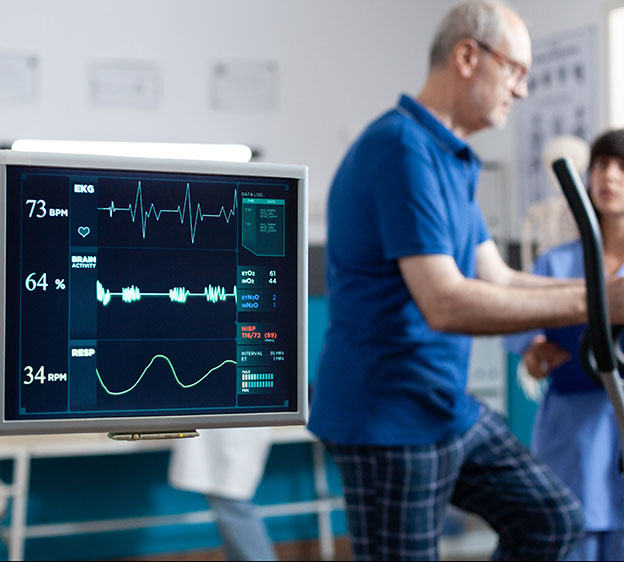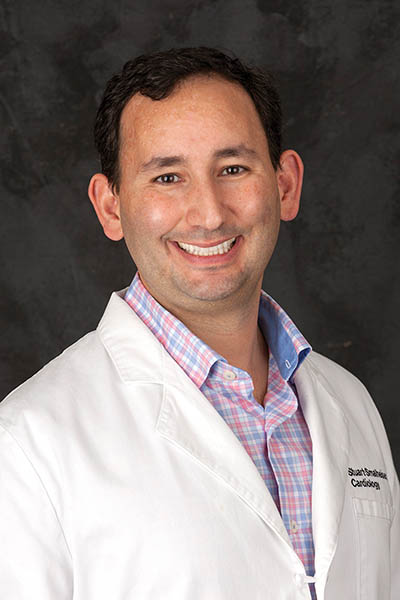
As recently as a few decades ago, doctors didn’t have many tools for understanding a person’s heart health other than by listening through a stethoscope. These days, a variety of heart tests give medical providers an in-depth look at how well your heart functions. Imaging tests can be used in an emergency to determine whether you’re having a cardiac event like a heart attack, and screenings have become part of routine medical care to check for signs of heart disease.
“Today, we have techniques and technologies that can provide us with a good deal of information about how well your heart functions,” says Dr. Stuart Smalheiser, an interventional cardiologist with Beaufort Memorial Heart Specialists. “These tests show the electrical activity of the heart, how your heart is beating and even give us a good look at how blood flows through the heart and blood vessels.”
Read More: Coronary Calcification: A Warning for Your Heart
1. Cardiac Catheterization
This procedure can be used to diagnose and treat blockages in the coronary arteries. A small tube called a catheter is inserted into a blood vessel, usually in the groin or wrist, then woven up to the heart. Once in place, cardiologists can insert tools to check for and even treat blockages using angioplasty.
2. Coronary Calcium Score
A coronary artery calcium screening is a noninvasive test that uses CT imaging to help determine your risk of a heart attack, even before you have symptoms of heart disease. Images taken during the scan show how much calcified plaque is inside of your coronary arteries. After the scan, you’ll be given a number, a “calcium score,” which shows your overall risk.
3. Echocardiogram
Echocardiography uses sound waves to create moving pictures showing the size and shape of the heart. Echocardiograms, also called echos, may be used to determine how well the heart’s chambers or valves are working, helping to diagnose structural heart disease, such as heart valve disease and cardiomyopathy.
4. Electrocardiogram
An EKG or ECG detects and records your heart’s electrical activity. It can be used to detect abnormal heart rhythms, a heart attack or heart failure, or as part of routine cardiology checkups. An EKG captures your heart’s activity at a specific point, but your cardiologist may also recommend Holter monitoring, a type of wearable EKG that records your heart’s activity for extended periods of time.
5. Stress Testing
An exercise stress test may be used to get a look at how your heart functions when it’s working hard. During this test, your blood pressure and heart rate will be measured while you walk on a treadmill or use an exercise bike. Your heart specialist may use other tests, including a nuclear heart scan or an echo, during a stress test to help determine what’s causing symptoms such as shortness of breath or chest pain.
Read More: How Healthy Is Your Heart? A Heart Scan Can Tell You
6. Abdominal Aortic Aneurysm Screening
Also known as an AAA scan, an abdominal aortic aneurysm screening is a painless abdominal ultrasound used to detect a serious, life-threatening bulge in the abdominal aorta. The U.S. Preventive Services Task Force recommends a one-time screening for men between ages 65 and 75 who have a history of smoking, but other people may also be screened.
7. Ankle-Brachial Index Test
An ankle-brachial index test is a simple, noninvasive screening used to detect peripheral arterial disease, or PAD. During this test, blood pressure is measured in both the arm and ankle and compared, with a lower ankle-brachial number indicating narrowing in the peripheral arteries.
8. Carotid Ultrasound
Carotid ultrasound is a painless test that uses sound waves to create detailed images of the carotid arteries, the blood vessels that supply blood to the brain. This scan may be paired with Doppler ultrasound to gauge how well blood flows through those arteries.
Read More: Carotid Artery Disease: Know the Signs
9. Cardiac CT or MRI Scan
CT and MRI scans are imaging tests used to capture detailed images of the heart muscle. CT scans use X-rays to create 3D images of your heart, while MRI uses radio waves and magnets to get a picture of your heart. Both tests can help diagnose coronary artery disease, congenital heart defects and heart valve disease, among other heart problems.
10. Chest X-Ray
This basic imaging test may be used to examine your heart, lungs and surrounding blood vessels. A chest X-ray can detect signs of heart failure, as well as conditions such as pneumonia and other lung-related conditions.
In addition to these common heart tests, other tests may be used to diagnose certain heart problems, including a heart attack. This can include blood tests to detect proteins and other substances released when the heart is damaged.
Wondering whether you could benefit from any of these heart tests? Schedule an appointment with a member of our heart care team in Beaufort or Okatie.

